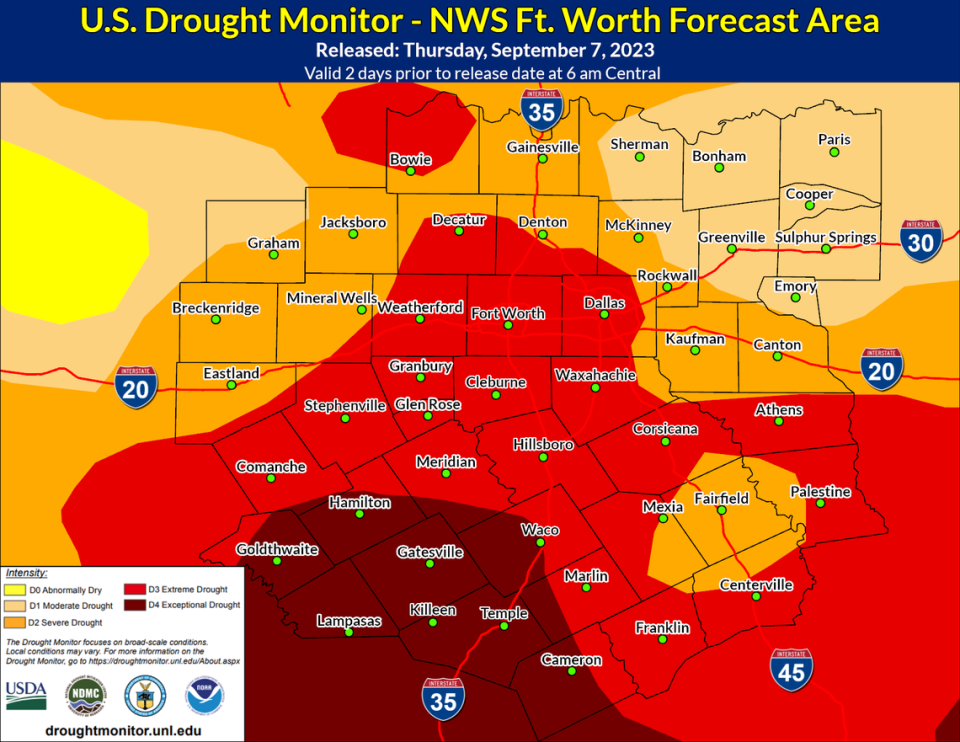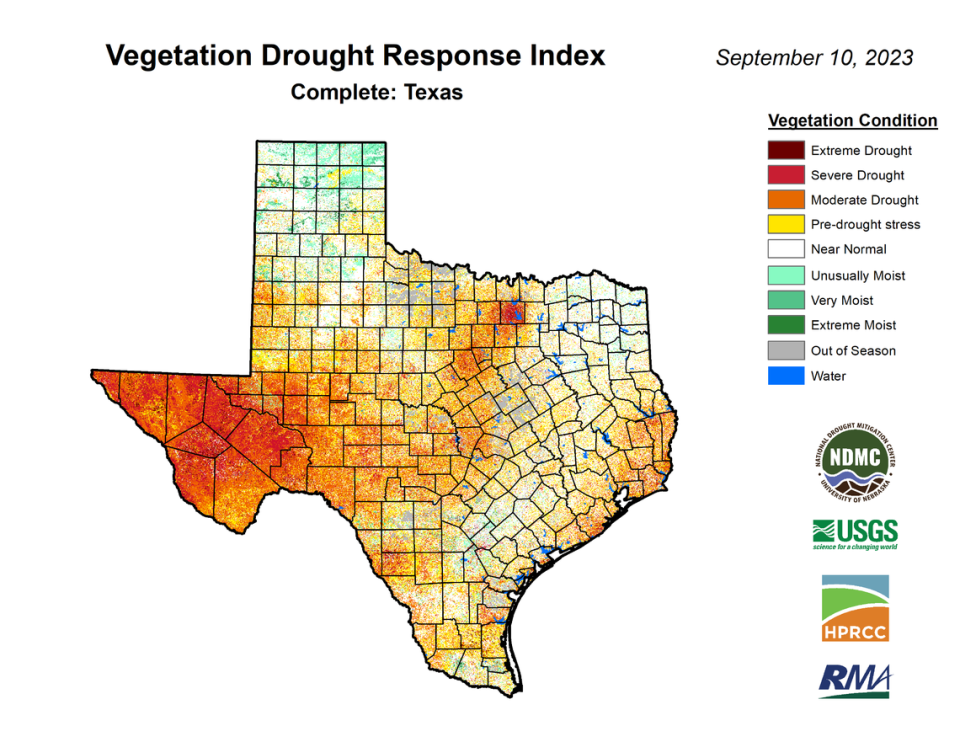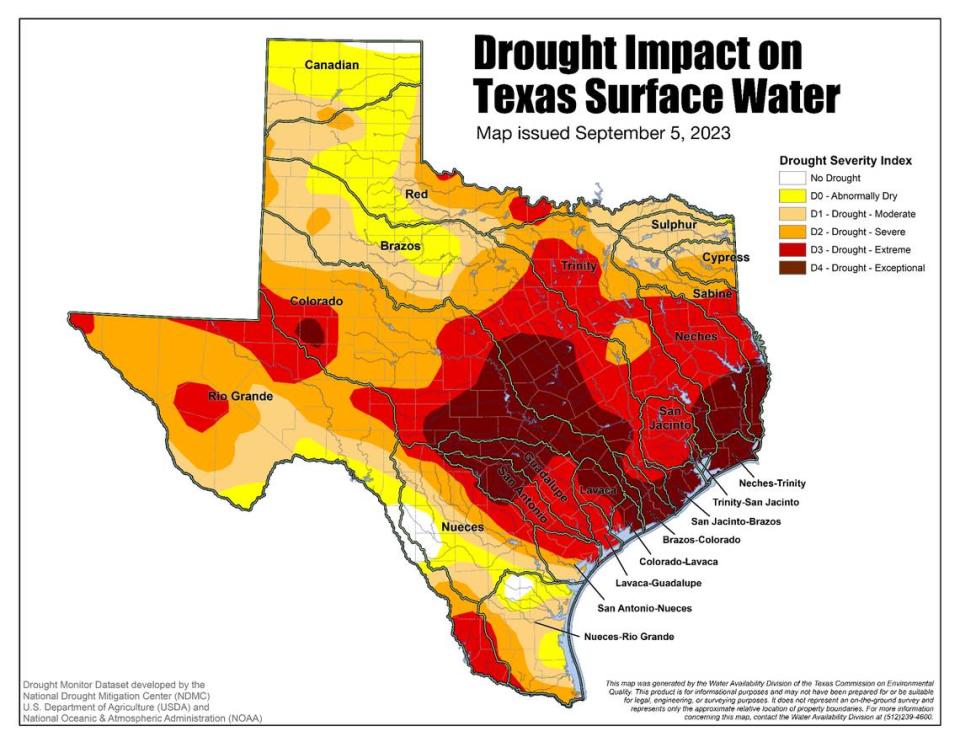150 Texas counties have USDA disaster labels due to drought. When will it finally let up?
Drought conditions are up by about 20% compared to a year ago, with 86% of Texas experiencing drought as of Sept. 5, up from 62% in 2022.
“Brutally hot and dry weather again this week kept dryness entrenched across Texas, southern Oklahoma, Louisiana, and southern Mississippi,” according to the U.S. Drought Monitor’s latest national drought summary.
Drought has only gotten worse throughout the sweltering summer, with little rain falling in Texas. Tropical Storm Harold in late August helped with the drought along the coast of Texas, but most of the state was left without relief and with temperatures four to eight degrees above normal, the Texas State Climatologist Dr. John Nielsen-Gammon said in a new report from Texas A&M AgriLife.
“The coast of Texas and the West Texas mountains were able to find temperature relief from recent rainfall, but most of the state has experienced triple degree weather with no relief expected in the near future,” Nielsen-Gammon said in the report.

Texas drought has worsened
Drought conditions are up 10% just in the last week, and by 58% compared with three months ago, according to the U.S. Drought Monitor. An estimated 24.4 million Texans are in drought areas. And 41% of Texas had extreme to exceptional drought, compared with only 9% a year ago.
The Drought Severity and Coverage Index, ranging from 0 to 500, is 306. That’s nearly double the DSCI in September 2022, at 186.
“The only difference between the 2022 and 2023 droughts is that the 2022 drought ended when rainfall started the second week of August,” Nielsen-Gammon told Texas A&M.
When this summer began, less than 18% of Dallas-Fort Worth was classified as being in drought, according to the National Weather Service in Fort Worth. By the end of the season, that number had grown to over 90%. Extreme drought returned in July, and exceptional drought in August. Extreme drought reached into North Central Texas, including Fort Worth.
For many locations in extreme to exceptional drought areas, summer rainfall was less than 25% of normal, according to NWS Fort Worth, much of that falling during June. With minimal rainfall during July and August, summer precipitation totals in those areas were among the driest on record.
“In North Central Texas, some locations are experiencing the driest year of the new century, including DFW Airport and Denton,” says the drought information statement issued by NWS Fort Worth on Aug. 31.
Texas Current Water Availability and Conditions
This map shows the current Texas water conditions by watershed and currently available data for streams and reservoirs. Use the buttons below to switch the map's focus to drought conditions and above and below average stream and reservoir levels. Tap on watersheds, streams and reservoirs for more information on levels and flow rates. Water conditions are color coded with blues indicating above-normal conditions, green being normal and yellow and red indicating below-normal conditions. The streamflow and reservoir information is in real-time, and watershed information is updated daily.
SOURCES: Environmental Protection Agency, USGS National Water Information System, ESRI and US Drought Monitor.
Drought’s impact
With this year’s drought, 150 Texas counties have USDA disaster designations, and 215 counties have implemented outdoor burn bans.
As of Sept. 5, 61% of Texas cotton was in poor or very poor condition. Peanuts, sorghum, soybeans and rice planted in Texas were also being stressed from the heat and lack of rainfall. In addition, as of early September, 72% of Texas rangelands were in poor or very poor condition.

As for the drought’s impact on water supply, statewide storage as of Aug. 27 was at 69% of conservation storage capacity, about 14 percentage points below what is considered normal for this time of year, per the Texas Water Development Board.

How long will the drought persist?
The U.S. Seasonal Drought Outlook released by the Climate Prediction Center on Aug. 31 shows that the drought will continue through Nov. 30.
September and October are usually wet months for Texas, according to Texas A&M, but since rain has been infrequent, this month is expected to lack rainfall.
But the remaining three months of 2023 have increased rainfall chances toward the west side of Texas as El Niño progresses. El Niño leads to cooler and wetter weather in Texas from late fall to mid-spring.
While there isn’t much rain in the forecast for the foreseeable future, we will hopefully see extreme rainfall as El Nino approaches, Nielsen-Gammon says.
“After one of the driest summers on record, drought conditions rapidly intensified across the region,” the National Weather Service in Fort Worth states. “Although El Niño may enhance precipitation amounts during the cold season, extraordinary deficits will take some time to reverse. As such, the ongoing drought is likely to persist or worsen through the fall rainy season.”
Until significant rainfall occurs, NWS Fort Worth says, vegetation will remain conducive to fires this autumn, even after the extreme heat comes to an end. The highest wildfire risk will be on days that are sunny and warm with low humidity and breezy winds.

